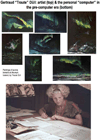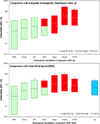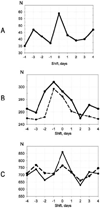27-day cycles in human mortality: Traute and Bernhard Düll
- PMID: 24224144
- PMCID: PMC3819124
- DOI: 10.5194/hgss-4-47-2013
27-day cycles in human mortality: Traute and Bernhard Düll
Abstract
This tribute to her parents by one co-author (NDP) is the fruit of a more than a decade-long search by the senior author (FH) for the details of the lives of Bernhard and Gertraud ("Traute") Düll. These pioneers studied how space/terrestrial weather may differentially influence human mortality from various causes, the 27-day mortality pattern being different whether death was from cardiac or respiratory disease, or from suicide. FH is the translator of personal information about her parents provided by NDP in German. Figuratively, he also attempts to "translate" the Dülls' contribution in the context of the literature that had appeared before their work and after their deaths. Although the Dülls published in a then leading journal, among others (and FH had re-analyzed some of their work in a medical journal), they were unknown to academies or libraries (where FH had inquired about them). The Dülls thoroughly assembled death certificates to offer the most powerful evidence for an effect of solar activity reflected in human mortality, as did others before them. They went several steps further than their predecessors, however. They were the first to show possibly differential effects of space and/or Earth weather with respect to suicide and other deaths associated with the nervous and sensory systems vs. death from cardiac or respiratory disease as well as overall death by differences in the phase of a common 27-day cycle characterizing these mortality patterns. Furthermore, Bernhard Düll developed tests of human visual and auditory reaction time to study effects of weather and solar activity, publishing a book (his professorial dissertation) on the topic. His unpublished finding of an increased incidence of airplane crashes in association with higher solar activity was validated after his death, among others, by Tatiana Zenchenko and A. M. Merzlyi.
Figures












Similar articles
-
Space weather and human deaths distribution: 25 years' observation (Lithuania, 1989-2013).J Basic Clin Physiol Pharmacol. 2015 Sep;26(5):433-41. doi: 10.1515/jbcpp-2014-0125. J Basic Clin Physiol Pharmacol. 2015. PMID: 26068901
-
"Just Another Statistic".Oncologist. 1998;3(3):III-IV. Oncologist. 1998. PMID: 10388105
-
Chronoastrobiology: proposal, nine conferences, heliogeomagnetics, transyears, near-weeks, near-decades, phylogenetic and ontogenetic memories.Biomed Pharmacother. 2004 Oct;58 Suppl 1:S150-87. doi: 10.1016/s0753-3322(04)80025-8. Biomed Pharmacother. 2004. PMID: 15754855
-
[Death certificates for suicides: quality investigation based on police records].Bundesgesundheitsblatt Gesundheitsforschung Gesundheitsschutz. 2019 Dec;62(12):1422-1426. doi: 10.1007/s00103-019-03039-0. Bundesgesundheitsblatt Gesundheitsforschung Gesundheitsschutz. 2019. PMID: 31690975 Review. German.
-
Sudden cardiac death: a nationwide cohort study among the young.Dan Med J. 2016 Dec;63(12):B5321. Dan Med J. 2016. PMID: 27910804 Review.
Cited by
-
Some Near- and Far-Environmental Effects on Human Health and Disease with a Focus on the Cardiovascular System.Int J Environ Res Public Health. 2020 Apr 29;17(9):3083. doi: 10.3390/ijerph17093083. Int J Environ Res Public Health. 2020. PMID: 32365467 Free PMC article. Review.
-
Major upwelling and overturning in the mid-latitude F region ionosphere.Nat Commun. 2018 Aug 20;9(1):3326. doi: 10.1038/s41467-018-05809-x. Nat Commun. 2018. PMID: 30127361 Free PMC article.
References
-
- Bartels J. Terrestrial-magnetic activity and its relation to solar phenomena. Terr. Magn. Atmos. Electr. 1932;37:1–52.
-
- Chizhevsky AL. Les périodes solaires et la mortalité. La Côte d’Azur médicale (Toulon) 11, No. 1930a;9:232.
-
- Chizhevsky AL. La Natalité et la tension de l’activite solaire. La Côte d’Azur médicale (Toulon) 1930b;11:2.
-
- Chizhevsky AL. Influences des variations de l’activité solaire sur la natalité et sur la mortalité. Bulletin de l’Académie du Var (Toulon) 1931a;Vol. 98
-
- Chizhevsky AL. L’activité solaire et la mortalité. Bulletin de l’Academie du Var (Toulon) 1931b;Vol. 98
Grants and funding
LinkOut - more resources
Full Text Sources
Other Literature Sources
Miscellaneous
